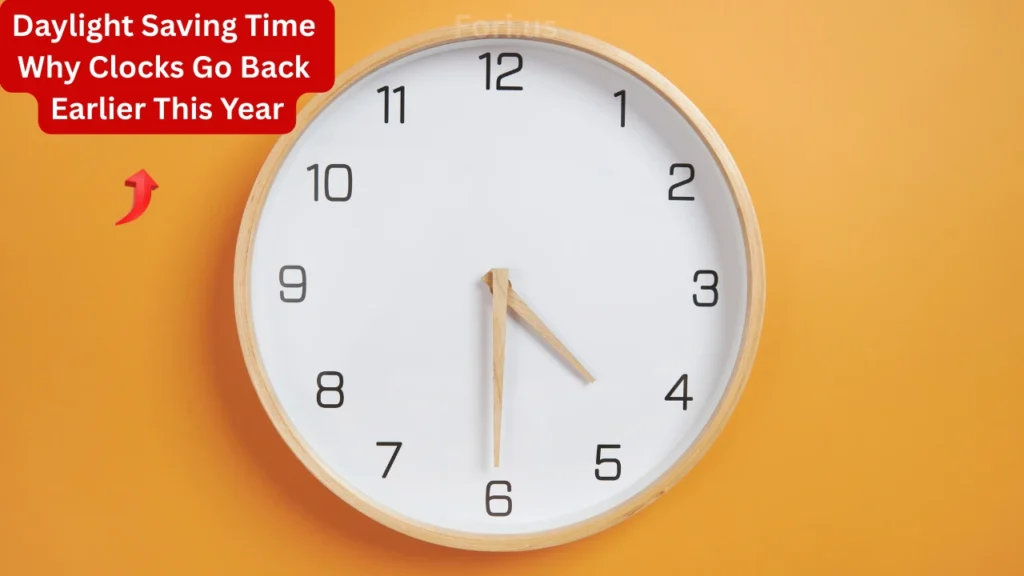This year’s end of Daylight Saving Time comes sooner than many expect. On Sunday, November 2, 2025, Americans will roll clocks back by one hour at 2:00 a.m. The change signals a return to standard time and marks one of the earliest possible fall transitions.
The shift means brighter mornings but shorter evenings. It also brings adjustments for sleep cycles, daily routines, and even household safety. Knowing the exact date, understanding its impact, and preparing in advance helps make the switch easier.
Is Purslane a Perennial? Growing & Eating Guide

Daylight Saving Time Ends November 2: What to Expect
| Date of Change | Sunday, November 2, 2025 |
| Time | 2:00 a.m., clocks move back one hour |
| Affected Devices | Smartphones and computers update automatically; ovens, microwaves, wall clocks, and car dashboards need manual reset |
| Key Impacts | Extra morning light, darker evenings, sleep adjustment, safety reminders |
| Exceptions | Arizona (except Navajo Nation), Hawaii, Puerto Rico, Guam, and U.S. Virgin Islands do not observe Daylight Saving Time |
When the Change Happens
Daylight Saving Time always ends on the first Sunday of November. In 2025, that falls on November 2. At 2:00 a.m., clocks shift back to 1:00 a.m., effectively granting an extra hour.
Most phones, laptops, and smart devices update automatically. But many household appliances and vehicles require manual resetting. Failing to reset these clocks can create confusion with appointments and daily schedules.
Why Daylight Saving Time Ends Earlier This Year
Because November 2 is the first Sunday of the month, it is the earliest possible end date for Daylight Saving Time. While the rule stays the same each year, the calendar can make the shift feel earlier or later. This time, the adjustment comes right at the start of the month, making it feel like the seasonal change is arriving quickly.
Extinct Trees of North America: Vanished Forests
How the Change Affects Daily Life
While gaining an hour of rest sounds positive, the transition affects more than just bedtime.
- Morning routines: Extra daylight in the early hours makes mornings feel brighter and safer.
- Evenings: Darkness comes sooner, often before dinner, cutting time for outdoor activities.
- Work and school: Adjustments in commute times and schedules are needed, especially with darker evenings.
- Mood and energy: Some people report fatigue, difficulty concentrating, or mood swings during the transition.
For many families, the hardest part is keeping consistent dinner and bedtime schedules, especially for children.
Health Considerations During the Shift
Even though “falling back” is often easier than the spring transition, experts note that the body’s internal clock still needs time to adapt. To handle the change better:
- Go to bed 15–20 minutes earlier in the days leading up to November 2.
- Spend time in morning sunlight to help reset your internal rhythm.
- Keep a steady wake-up schedule, even on weekends.
- Limit phone and laptop use before bedtime.
- Stay active during the day to avoid sluggishness.
Some individuals may also notice signs of seasonal affective disorder (SAD), which tends to increase when daylight hours grow shorter. Staying connected with morning sunlight and daily exercise can reduce those symptoms.
Safety Concerns Linked to the Change
The end of Daylight Saving Time comes with seasonal safety risks.
- Road safety: Evening commutes happen in darker conditions, increasing accident risks for both drivers and pedestrians. Reflective clothing, headlights, and extra caution become important.
- Home safety: Fire officials recommend using the clock change as a reminder to replace batteries in smoke alarms and carbon monoxide detectors. Taking this step twice a year aligns with the spring and fall clock changes.
By using the time shift as a reminder, families can improve both health and safety at home.
Regions That Do Not Observe Daylight Saving Time
Not every U.S. location follows the time change.
- Arizona (except the Navajo Nation) and Hawaii remain on standard time year-round.
- U.S. territories, including Puerto Rico, Guam, and the Virgin Islands, also do not participate.
Over recent years, debates in Congress have explored making Daylight Saving Time permanent, but no law has been passed. As of 2025, the twice-yearly shift continues.
Medicare Savings Worth $2,400 Often Left Unclaimed
Preparing for the Transition
A little planning can reduce the stress of the switch:
- Reset analog clocks before going to bed on Saturday night.
- Replace batteries in safety devices like smoke alarms.
- Prepare for earlier nightfall by finishing errands before dusk.
- Adjust sleep patterns gradually in the days before the change.
- Schedule outdoor activities for morning or early afternoon.
These small steps can make the adjustment smoother for both individuals and families.
Everyday Impact of the Time Change
Beyond personal routines, Daylight Saving Time influences broader areas:
- Business hours: Retailers may see changes in shopping patterns as evenings darken earlier.
- Transportation: Commuters experience darker drives home, with more reliance on headlights.
- Energy use: While originally created to conserve energy, modern research shows mixed results on whether the shift still saves electricity.
- Community life: Events, sports, and outdoor gatherings often need rescheduling around shorter daylight windows.
The effect reaches far beyond sleep, shaping how communities function during the fall and winter months.
FAQs About Daylight Saving Time Ends Soon
It ends on Sunday, November 2, at 2:00 a.m., when clocks move back by one hour.
No. Smartphones and computers typically adjust on their own, but household appliances and car clocks must be changed manually.
Because November 2 is the first Sunday of the month, it is the earliest possible date for Daylight Saving Time to end.
Arizona (except the Navajo Nation), Hawaii, Puerto Rico, Guam, and the U.S. Virgin Islands do not follow Daylight Saving Time.
Reset clocks before bed, replace safety device batteries, and adjust your sleep schedule gradually for easier adaptation.
The end of Daylight Saving Time on November 2, 2025, marks one of the earliest possible seasonal changes. While it brings brighter mornings, it also shortens daylight in the evenings, affecting health, safety, and daily routines.
By preparing early — adjusting sleep, checking household clocks, and updating safety devices — the transition can be smoother and less disruptive. This shift is more than just turning back the clock; it’s an opportunity to refresh habits and prepare for the winter season ahead.
